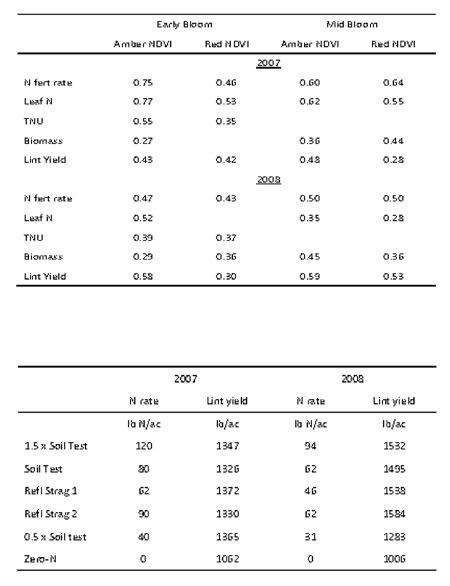Use Of Active Sensors To Monitor In-Season Nitrogen Status Of Cotton
Summary
Monitoring of cotton N status is important in guiding in-season N fertilization. Historically, this has been done with petiole nitrate analysis. Recently, hand-held or tool-bar mounted spectroradiometers have been tested for this purpose. These canopy reflectance sensors have their own light source, and are therefore called “active” sensors. This is in contrast to reflectance sensors that rely on natural light, which is a limitation on cloudy days. Reflectance in two wave-lengths is measured, a near infrared (NIR) and a visible (red or amber) region. The ratio of NIR to visible reflectance, e.g. Normalized difference vegetation index (NDVI) was correlated to both cotton biomass and N status, i.e. Leaf N or total N uptake (TNU). We also tested two different in-season N management approaches for irrigated cotton, based canopy reflectance. Every two weeks from first square to mid bloom, active sensor measurements were made. Reflectance-based N management generally resulted in modest N fertilizer savings compared to conventional, soil-test based N management. No loss of lint or seed yield was observed with sensor management.
Methods
The study was conducted at the Texas A&M Research and Extension Center farm near Lubbock, TX on an Acuff sandy clay loam. Drip tape was in the center of every other furrow at a depth of 12 and water flowed at a rate of 1 L min-1 at 0.08 MPa. AFD 5065 B2F was planted on 6 June in 2007 and on 13 May in 2008. Harvest was in November each year. The experimental design was a randomized complete block design, oneway factorial with three replications or blocks. Blocks consisted of 40, 40-in. rows that were 600 feet long. Each block was divided into five, 8-row plots that were randomly assigned to the five
Every week canopy reflectance measurements were made with the CropCircle and GreenSeeker radiometer at 40 inches above the canopy on one row per plot. Normalized difference vegetative index (NDVI) was calculated as:
(Reflectance at NIR - Reflectance at visible)/( Reflectance at NIR + Reflectance at visible)
When the NDVI in the reflectance-based strategy 1 treatments fell significantly below the NDVI in the soil test based management treatment, the N injection rate was increased to the soil test treatment N injection rate. When the NDVI in the reflectance-based strategy 2 treatments fell significantly below the NDVI in the 1.5 * soil test based management treatment, the N injection rate was increased to the 1.5 * soil test treatment N rate. Plant samples were taken at early bloom and at mid bloom for biomass measurements, leaf and stem N analysis.
Results and Discussion
Correlations between NDVI and N Rate and leaf N were strong in 2007, and moderate in 2008
(Table 1). Lint yield correlations with NDVI were greatest in 2008. Correlation between NDVI and biomass were less than with leaf N in 2007 but similar to leaf N in 2008. These results are similar to the magnitude of the correlations we previously reported with passive sensors on LEPA, subsurface drip and surface drip irrigations (Bronson et al., 2003). Lint yields in 2007 were similar among all Nfertilized treatments and were greater than the zero-N yields (Table 2). In 2008, lint yields in the 0.5 x Soil Test treatments were significantly lower than the other N-fertilized treatments. Reflectance strategy 1resulted in modest N fertilizer savings of 18 and 16 lb N/ac vis a vis the soil test treatment, respectively. The reflectance strategy 2 resulted in 10 lb N/ac greater N rate than the soil test approach in 2007 and the same N rate in 2008. Lint yields did not differ among soil test and reflectance strategies 1 and 2 in either year. In summary, the reflectance strategy 1 resulted in modest savings of N fertilizer without hurting yields, compared to the current soil test based recommendations. This result is similar to our earlier work with a passive sensor on LEPA, subsurface drip and surface drip irrigation (Chua et al., 2003 Yabaji et al., 2009)
References
Bronson, K.F., T.T. Chua, J.D. Booker, J.W. Keeling, and R.J. Lascano. 2003. In-season nitrogen status sensing in irrigated cotton: II. Leaf nitrogen and biomass. Soil Sci. Soc. Am. J. 67:1439-1448.
Chua, T.T., K. F. Bronson, J.D. Booker, J.W. Keeling, A.R. Mosier, J.P. Bordovsky, R.J. Lascano, C.J. Green, and E. Segarra. 2003. In-season nitrogen status sensing in irrigated cotton: I. Yield and nitrogen-15 recovery. Soil Sci. Soc. Am. J. 67:1428-1438.
Yabaji, Rajkumari, K. F. Bronson, A. Malapati, J. W. Nusz, J. D. Booker, R.L. Nichols, B. Mullinx, and T. L. Thompson. 2009. Nitrogen management for subsurface drip irrigated cotton: Ammonium thiosufalte, timing, and canopy reflectance. Soil Sci. Soc. Am. J. 72: (Accepted). Δ

Table 1. Correlations between NDVI from active sensors and cotton N status and yield parameters,
Table 2. Lint yield and N fertilizer applied as affected by reflectance based N management, Lubbock, TX,